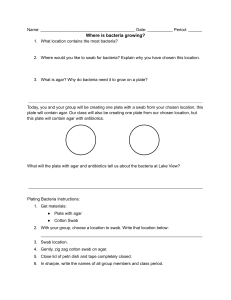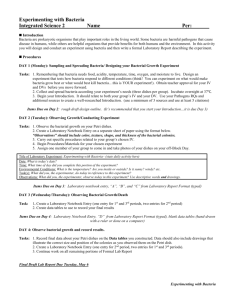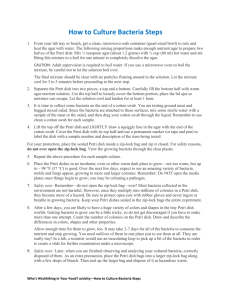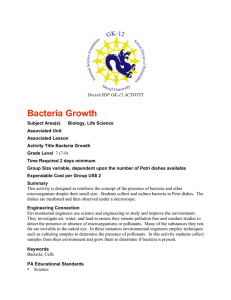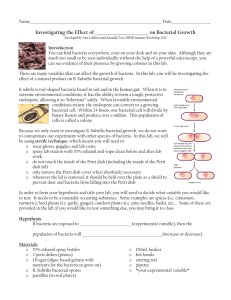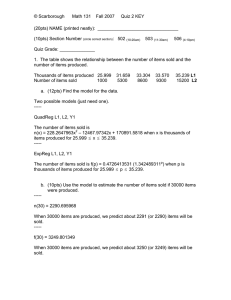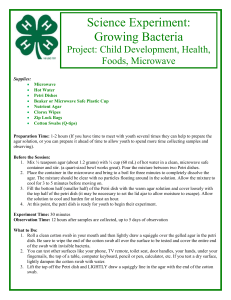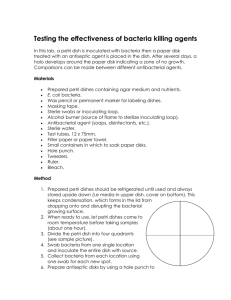Lab Handout
advertisement
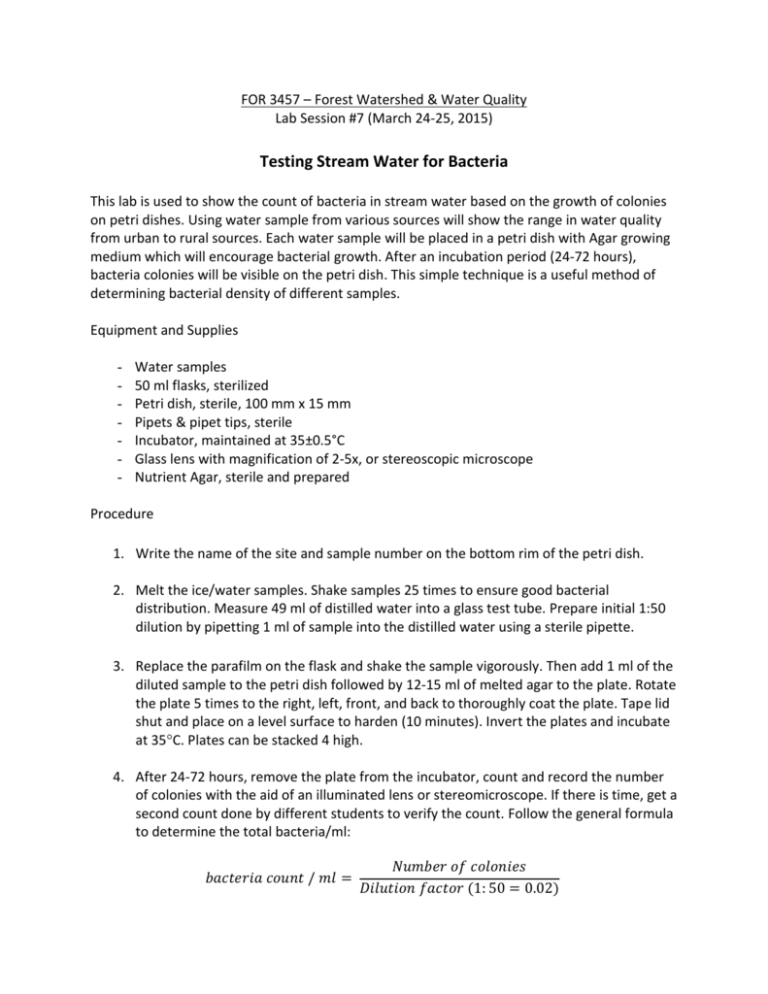
FOR 3457 – Forest Watershed & Water Quality Lab Session #7 (March 24-25, 2015) Testing Stream Water for Bacteria This lab is used to show the count of bacteria in stream water based on the growth of colonies on petri dishes. Using water sample from various sources will show the range in water quality from urban to rural sources. Each water sample will be placed in a petri dish with Agar growing medium which will encourage bacterial growth. After an incubation period (24-72 hours), bacteria colonies will be visible on the petri dish. This simple technique is a useful method of determining bacterial density of different samples. Equipment and Supplies - Water samples 50 ml flasks, sterilized Petri dish, sterile, 100 mm x 15 mm Pipets & pipet tips, sterile Incubator, maintained at 35±0.5°C Glass lens with magnification of 2-5x, or stereoscopic microscope Nutrient Agar, sterile and prepared Procedure 1. Write the name of the site and sample number on the bottom rim of the petri dish. 2. Melt the ice/water samples. Shake samples 25 times to ensure good bacterial distribution. Measure 49 ml of distilled water into a glass test tube. Prepare initial 1:50 dilution by pipetting 1 ml of sample into the distilled water using a sterile pipette. 3. Replace the parafilm on the flask and shake the sample vigorously. Then add 1 ml of the diluted sample to the petri dish followed by 12-15 ml of melted agar to the plate. Rotate the plate 5 times to the right, left, front, and back to thoroughly coat the plate. Tape lid shut and place on a level surface to harden (10 minutes). Invert the plates and incubate at 35°C. Plates can be stacked 4 high. 4. After 24-72 hours, remove the plate from the incubator, count and record the number of colonies with the aid of an illuminated lens or stereomicroscope. If there is time, get a second count done by different students to verify the count. Follow the general formula to determine the total bacteria/ml: 𝑏𝑎𝑐𝑡𝑒𝑟𝑖𝑎 𝑐𝑜𝑢𝑛𝑡 / 𝑚𝑙 = 𝑁𝑢𝑚𝑏𝑒𝑟 𝑜𝑓 𝑐𝑜𝑙𝑜𝑛𝑖𝑒𝑠 𝐷𝑖𝑙𝑢𝑡𝑖𝑜𝑛 𝑓𝑎𝑐𝑡𝑜𝑟 (1: 50 = 0.02) Report Outline The purpose of this lab is to compare the results of bacteria (#/ml) across all of the study sites. In your analysis, try and showcase any trends that form. Use previous lab results and compare bacteria to OM levels, DO levels, etc… Also you could potentially look at previous year’s data to show trends. In your introduction, introduce the water born bacteria. Elaborate and research the importance of looking at bacteria levels in terms of water quality, and the role different bacteria play in various watershed types. Methods should include a detailed overall explanation at what was done in the lab with the plates, as well as any explanations needed for any statistical work. Results should include a table of results (might be suitable for an appendix depending on size), as well as any statistical results. Focus on any relationships between different lab results from previous labs and the bacteria level. (Please do not forget to talk about results in this section. Don’t just plop tables and graphs here, you need to introduce and talk about them). Your discussion section is where you talk about your results, and elaborate on the trends/relationships found. This section is important and should include research and references to support your findings. You should also focus on the belief and trust regarding the outcomes of the results i.e. reliability, uncertainty, representativeness, appropriateness. Discuss the results but also the methods in which you found them and their reliability. Conclude your report with stated objectives and the overall lesson learnt. (Don’t forget appendices and reference) Report worth: *Title Introduction - 20 Methods - 15 Results - 20 Discussion - 30 Conclusion - 5 *References *Appendix *Title, References, Appendix together: 10 Notes: You need a title page with a title that is descriptive and creative. Make sure to have appropriate references. We discourage the use of web based references. Utilize the library and the online archives to find actual scientific references and books. Make sure to have a properly formatted list of references. Appendices should each have a title. Number your pages, and remember that page 1 starts with your writing, not with the table of contents (if you chose to add one). This report is marked from a 3rd year university level, therefore be sure to write and format appropriately.

